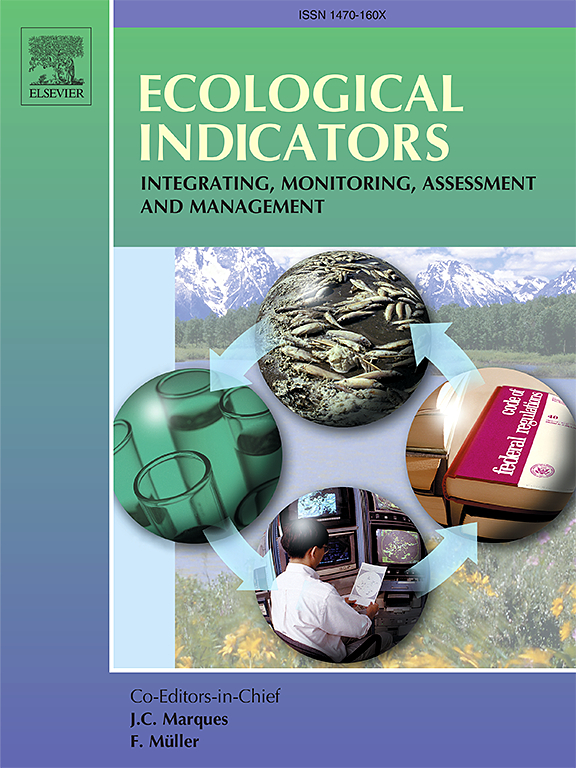评估冬季城市公园鸟类多样性的驱动因素:来自声学指数的见解
IF 7
2区 环境科学与生态学
Q1 ENVIRONMENTAL SCIENCES
引用次数: 0
摘要
随着城市化进程的加快,城市生态系统的生物多样性面临越来越大的挑战。鸟类作为指示物种,可以反映生态系统的健康状况。城市公园为鸟类提供了重要的栖息地和繁殖地,在缓解城市化压力方面发挥着至关重要的作用。随着数据采集自动化和大数据的发展,被动声监测技术在生态学研究中得到了迅速发展。PAM在森林生态监测和评价中得到了广泛的应用,并建立了声学指标来估计动物多样性。然而,它在城市鸟类活动中的应用,特别是在冬季条件下,仍然没有得到充分的探索。本研究利用PAM对南京地区冬季鸟类的声学活动进行了评价。研究在10个城市公园的30个采样点进行了24 h的记录,并利用这些数据计算了通过野外调查和基于gis的空间分析获得的6种常见声学指数、植被特征和人为变量。本研究的目的是确定冬季城市环境中影响鸟类声学活动的主要植被和人为因素,并为城市生态系统保护策略提供依据。结果表明:(1)声学指标能较好地反映鸟类生物活动的日变化,冬季南京地区鸟类的黎明合唱随着气温的降低而延迟。㈡植被结构显著影响鸟类多样性,冬季城市公园内灌木丰富的植被尤其有利。(iii)人为干扰,例如城市噪音,对鸟类的多样性造成负面影响。本文章由计算机程序翻译,如有差异,请以英文原文为准。

Assessing the drivers of bird diversity in urban parks during winter: Insights from acoustic indices
As urbanisation accelerates, the biodiversity of urban ecosystems faces increasing challenges. Birds as indicator species, can reflect ecosystem health. Urban parks play a vital role in mitigating the pressures of urbanisation by providing critical habitats and breeding sites for birds. Passive acoustic monitoring (PAM) techniques have rapidly progressed in ecological research with automated data collection and big data development. PAM has been widely used in forest ecological monitoring and assessment, with acoustic indices developed to estimate faunal diversity. However, its application to urban bird activity, particularly under winter conditions, remains underexplored. In this study, PAM was used to assess the acoustic activity of winter birds in Nanjing, China. The study recorded at 30 sampling points in 10 urban parks for a duration of 24 h and used these data to calculate six common acoustic indices, vegetation characteristics and anthropogenic variables obtained through field surveys and GIS-based spatial analysis. The objective of this study was to identify the key vegetation and anthropogenic factors influencing bird acoustic activity in urban environments during winter, and to provide insights into urban ecosystem conservation strategies. We conclude that (i) acoustic indices can reflect the diurnal variation of bird biological activities, and the dawn chorus of birds in Nanjing during winter is delayed as temperatures decrease. (ii) Vegetation structure significantly influences bird diversity, with shrub-rich vegetation in urban parks during winter proving particularly favourable. (iii) Anthropogenic disturbances such as urban noise negatively affect bird diversity.
求助全文
通过发布文献求助,成功后即可免费获取论文全文。
去求助
来源期刊

Ecological Indicators
环境科学-环境科学
CiteScore
11.80
自引率
8.70%
发文量
1163
审稿时长
78 days
期刊介绍:
The ultimate aim of Ecological Indicators is to integrate the monitoring and assessment of ecological and environmental indicators with management practices. The journal provides a forum for the discussion of the applied scientific development and review of traditional indicator approaches as well as for theoretical, modelling and quantitative applications such as index development. Research into the following areas will be published.
• All aspects of ecological and environmental indicators and indices.
• New indicators, and new approaches and methods for indicator development, testing and use.
• Development and modelling of indices, e.g. application of indicator suites across multiple scales and resources.
• Analysis and research of resource, system- and scale-specific indicators.
• Methods for integration of social and other valuation metrics for the production of scientifically rigorous and politically-relevant assessments using indicator-based monitoring and assessment programs.
• How research indicators can be transformed into direct application for management purposes.
• Broader assessment objectives and methods, e.g. biodiversity, biological integrity, and sustainability, through the use of indicators.
• Resource-specific indicators such as landscape, agroecosystems, forests, wetlands, etc.
 求助内容:
求助内容: 应助结果提醒方式:
应助结果提醒方式:


